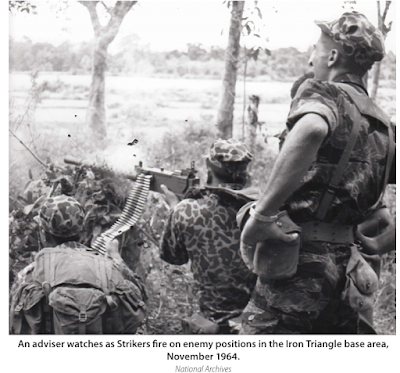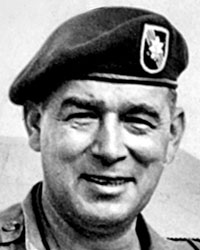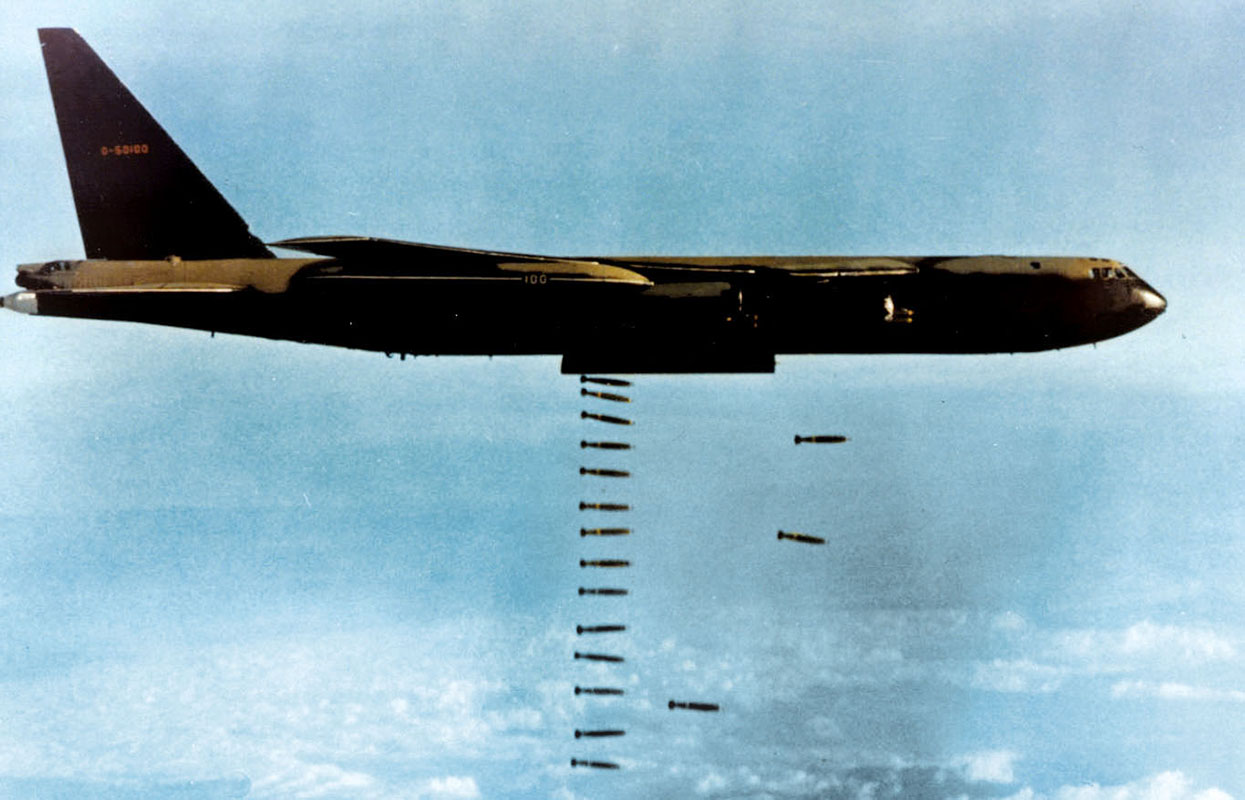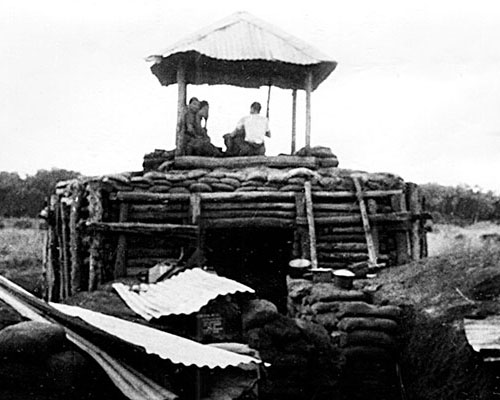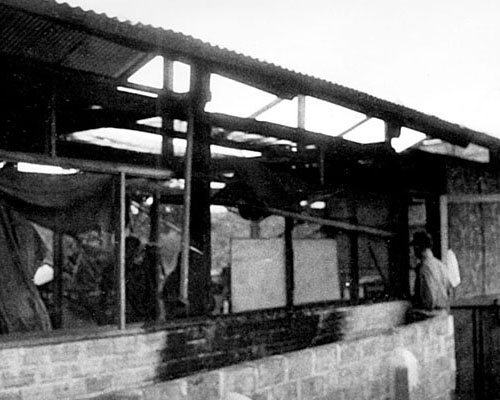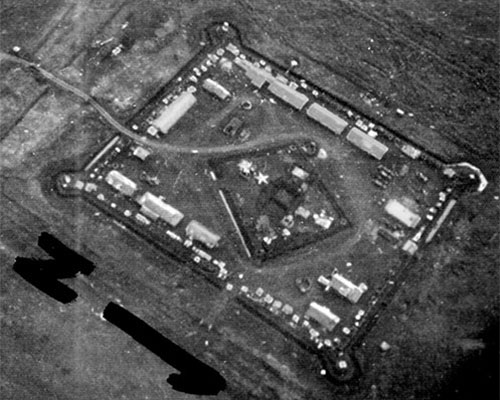The Tien Giang Tactical Area
During the first half of 1964, the autonomous Tien Giang Tactical Area south of Saigon
had been one of the most contentious places in South Vietnam. The summer mon
soons brought no relief, as the number of enemy incidents in the third quarter of 1964
increased by 52 percent over the previous quarter. As was the case with other divi
sions, the 7th Division, which controlled the area, tried to achieve a balance between
pacification and offensive operations, but the need to react to enemy initiatives often
disrupted this effort.40
Using the Cushman concept as a model (see Chapter 6), by July, the division had its
own pacification cadre trained by division and province personnel. One American and
six Vietnamese MEDCAP teams actively treated the rural sick. Division senior adviser
Col. Edward Markey credited the division’s educational efforts in getting tactical units
to be more sympathetic to the population. By July, the division had completed 106 of
the 405 New Life hamlets planned for 1964.
T
he division relied heavily on artillery to perform its mission. Howitzers covered
85 percent of the Tien Giang area and helped repulse 218 of 243 attacks in July. During
that same month, government pieces expended more than 6,000 rounds in harassment
and interdiction fire that produced 200 known casualties. In one incident, 105-mm.
howitzers fired fifty rounds based on information provided by a civilian, killing
twenty-four insurgents. The enemy evacuated about seventy additional casualties
before troops arrived.41
U.S. Army Aviation also played a key role. The division typically ran three to
four “Eagle flights” per week, in which U.S. helicopters ferried Vietnamese soldiers
of platoon or company strength over the countryside in search of insurgents. The
modus operandi was for Colonel Markey and the division G–3 to take to the air in a
command-and-control helicopter. If they saw something suspicious, they would send
in a helicopter bearing a squad from the division’s reconnaissance company. During a
typical flight, they would drop five to ten squads to search multiple locations. If contact
occurred, they could call in the rest of the company, or even the divisional reserve—
two airborne battalions assigned to Tien Giang because of the area’s heavy fighting.
T
he technique was successful, but during one landing, Markey triggered a booby trap
that injured his leg. He returned to the United States for treatment.
On 22 June, the 1st and 3d Airborne Battalions were on a search-and-destroy
operation in support of the 7th Division near Bang Lang, Dinh Tuong Province,
72 kilometers southwest of Saigon when they ran into the 261st and 514th PLAF
Battalions. Enemy fire downed four U.S. Army helicopters, including one carrying the
commander of U.S. Army Support Command, General Joseph Stilwell. The general and
all the aviators emerged unscathed. Meanwhile, helicopter gunships lent their support
to the fight, at one point accidently inflicting nine casualties on the South Vietnamese.
T
he combat below was intense, with the paratroopers charging the enemy multiple
times. Hostile fire killed or wounded all nine platoon leaders in the 1st Battalion, but
the unit never wavered. The enemy retreated at the end of the day. The paratroopers
lost twenty-nine killed and eighty-nine wounded. Known enemy losses amounted to
f
ifty-eight killed, twenty-six fighters captured, and twenty weapons. One adviser called
the battle a “little classic of a military operation.” The Army awarded a Bronze Star and
two Silver Stars to three advisers who fought in the action. One of the men who earned
the Silver Star was Capt. James J. Lindsay, a future general.43
On 18 July, nearly one hundred U.S. helicopters ferried troops to Cao Lanh, Kien
Phong Province, 80 kilometers south of Saigon. The massive operation did not achieve
much, but the enemy shot down a helicopter that was evacuating wounded soldiers.
T
he crew of the downed aircraft fought the enemy for about ten minutes before
more helicopters arrived to rescue them. Troops also deployed to guard the downed
helicopter and a team of U.S. technicians. The craft flew out on its own power the
following day.44
At 0100 on 20 July, the revolutionaries launched a major attack of their own.
T
hey massed three battalions—the 261st, 263d, and 514th—and one company each of
recoilless rifles, machine guns, mortars, and sappers to attack Cai Be district town in
western Dinh Tuong. About 300 soldiers, drawn from a regimental headquarters and
local territorials, defended Cai Be. The insurgents penetrated the town and inflicted
much damage, particularly on the housing of Regional Forces families. They killed
twelve defenders and forty dependents. Another forty defenders and forty civilians
suffered injuries. The insurgents withdrew at 0500.45
T
he government responded with five battalions backed by armor to pin the enemy
against the Mekong River, 5 kilometers west of Cai Be. Two battalions saw the most
action. The 8th Airborne Battalion occupied Cai Be and then continued through sugar
cane and rice paddies until 1545 when enemy fire hit two of its companies. The lead
company advanced an additional 90 meters when heavy automatic weapons fire finally
stopped it. The second company faltered after enemy fire killed its commander and
radio operator. U.S. Army gunships fired 130 rockets as close as 45 meters in front of
friendly troops to keep the enemy at bay. The battalion eventually withdrew at 1900.
Meanwhile, at 1600, insurgent soldiers entrenched along a tree line pinned
down a company from the 6th Airborne Battalion. After some delay, the
battalion commander accepted his adviser’s recommendation to attempt a double
envelopment, but the move was too shallow, and the pincers hit the enemy’s front
rather than its flanks. At 1830, the battalion launched a frontal assault, assisted
by two armed U.S. Army Mohawk aircraft and several gunships. Unfortunately,
the gunships mistakenly hit the 6th Airborne, unnerving the unit, which then
recoiled into a perimeter for the night. After Vietnamese helicopters refused to
evacuate the casualties, a U.S. Army medevac helicopter arrived to remove twelve
wounded soldiers. The senior adviser to the Airborne Brigade, Col. John G.
Hayes, expressed disappointment at the lack of aggressiveness exhibited by the
airborne battalions that day. Thirteen Vietnamese paratroopers died and fifty-two
were wounded, as was one American. The enemy lost forty-six dead and a dozen
f
ighters taken prisoner. An adviser speculated that the allies had probably caused
another hundred casualties. Military Region 2 contended that by attacking Cai
Be it had made the South Vietnamese fearful of attacks on other district capitals.
Consequently, observed the command, “They are forced to split up to reinforce the
posts, and the morale of their troops is more apathetic than before.”46
T
he politico-military struggle continued in August. Pacification advanced
modestly. The number of constructed hamlets rose to 155, MEDCAP teams treated
20,000 sick civilians, and the division completed 18 civic action projects. Against
this backdrop, the killing continued. On the tenth, Col. Huynh Van Ton reacted
to information that a PLAF company was located 15 kilometers west of My Tho by
sending out four battalions (one airborne, one infantry, and two ranger) and an M113
troop supported by a platoon of 105-mm. howitzers. The armored carriers and the
airborne and infantry battalions advanced south from Highway 4 while the rangers
attacked from east to west from a position 5 kilometers to their south. All units made
contact, and an airstrike helped to kill forty-two enemy combatants. The insurgents
evacuated an estimated seventy more casualties. The South Vietnamese lost sixteen
dead and forty-one wounded.47
Ten days later, revolutionaries sprang a trap of their own. On 20 August, they
overran Phu Tuc post in Kien Hoa Province, 10 kilometers northwest of Ben Tre, killing
seven, wounding fifteen, and capturing the rest of the post’s thirty-six-man garrison.
T
he insurgents then burned the post and assaulted a nearby hamlet. These attacks were
primarily a pretext for goading the South Vietnamese into sending a relief force. The
government took the bait, sending elements of several battalions, which the insurgents
declined to engage. Instead, they waited until government troops were departing Phu
Tuc along a forest road, hitting the column when its guard was down. Caught in the
ambush were 360 soldiers from the 41st Ranger Battalion and the 3d Battalion, 12th
Infantry. The fighting lasted for more than an hour, with the 514th PLAF Battalion
launching repeated bayonet charges heralded by bugles.
Four Americans participated in the combat. 1st Lt. James M. Coyle was severely
wounded but nevertheless kept fighting. Capt. Bryan C. Stone found himself firing
a Browning automatic rifle in four directions as the enemy closed in around him.
1st Lt. William D. H. Ragin grabbed a machine gun from a dead soldier and fired
it point-blank at sixty advancing enemy soldiers. Moments before, he had thought
they were friendly because they were clothed in government uniforms. Assisted by
Sfc. Tom Ward, Stone, Coyle, and Ragin covered the retreat of the surviving South
Vietnamese. By the time the battle was over, the insurgents had killed 85 South
Vietnamese soldiers, wounded 60, and captured 122 weapons, with another 91
government soldiers missing. All four Americans died in the engagement. General
Westmoreland attended their memorial service, and the Army posthumously
awarded them Distinguished Service Crosses.48
Stung by the calamity, U.S. helicopter gunships attacked insurgents exiting the area
by boat that night as more troops rushed to the scene. Allied forces failed to contact the
enemy on the twenty-first, and on the night of 21–22 August, gunships again took to the
night sky looking for sampans. On the morning of the twenty-second, seven battalions,
two armored cavalry troops, and naval forces tried to encircle the enemy in Kien Hoa’s
Ham Long District. The first attempt failed, but Ton quickly redeployed his men by
boats and U.S. helicopters to catch the elusive foe. In the ensuing battle, 7th Division
artillery fired 3,222 rounds, and the Vietnamese Air Force flew 10 fighter-bomber
sorties. When the smoke cleared, the allies had killed ninety-eight PLAF soldiers
and captured forty-three prisoners and thirty-seven weapons. Agents reported that
the enemy buried another 200 dead and evacuated 300 wounded. Government losses
amounted to seventeen killed and forty-five wounded. Nevertheless, IV Corps adviser
Col. Sammie Homan thought that commanders were becoming cautious because of
the action on the twentieth and other recent ambuscades. To restore their confidence,
he pledged to use U.S. Army helicopters to escort all future troop movements.49
An example of the promised support occurred on 5 September, when five UH–1B
gunships from the 120th Aviation Company supported a 7th Division operation in
Dinh Tuong. The entrenched insurgents hit three of the gunships, compelling one
to return to base. The gunships in turn killed sixty revolutionaries and wounded an
estimated forty more. Thirty-four enemy soldiers surrendered after the onslaught.50
September brought new men to the top echelons of the 7th Division. Brig Gen.
Nguyen Bao Tri became division commander, and MACV appointed Col. Robert A.
Guenthner to advise him. Guenthner had received the Silver Star and Bronze Star
medals for bravery at Salerno and Anzio, Italy, during World War II. Before coming
to Vietnam, he had served as an adviser to the Nationalist Chinese army. Guenthner
continued Markey’s strong support for civic action, psychological warfare, and the
Chieu Hoi program. He had great respect for the U.S. Operations Mission personnel
working in the field. He also emphasized intelligence, most of which came from the
agent networks run by district, province, and division entities. The chief problem
with the networks was that information traveled slowly, as the agents, fearful that the
insurgents would detect them if they used radios, preferred to send reports by courier.
Information provided by civilians was also useful but tended to be exaggerated in
Guenthner’s opinion.51
As had previous commanders and advisers, Tri and Guenthner exploited the in
depth knowledge of Major Binh, who had accumulated extensive files over his seven
years of service in the division’s G–2 section. This data sometimes allowed Binh to
predict where the enemy might move next, and Guenthner established a joint planning
committee to target specific enemy units based on the data.52
Even if pattern analysis helped find enemy units, the division had little luck
penetrating the National Liberation Front’s political apparatus. The Front employed
strict security measures, and because torture and death awaited anyone it discovered to
be a government agent, few were willing to attempt to penetrate enemy organizations.
As Americans had found elsewhere, Guenthner discovered that even after the
government had identified a clandestine Front cadre, “there is not an aggressive
program designed to eliminate these persons.” When a suspect did fall in to the
military’s hands, the colonel considered South Vietnamese interrogation procedures
to be poor and accompanied by “unnecessary shouting, shoving, hitting, and kicking
of the captive.”53
September brought one other development in addition to the change in command.
On 5 September, the Joint General Staff abolished the Tien Giang Tactical Area. It
transferred the 7th Division and four of the five provinces it supervised to IV Corps
and assigned Long An Province to III Corps. Over the summer months, the division
and its provinces had managed to bring about 50,000 more people into the most secure
category of government control, but the allies conceded that the majority of the area’s
residents, nearly one million people, remained under the domination of the National
Liberation Front.



